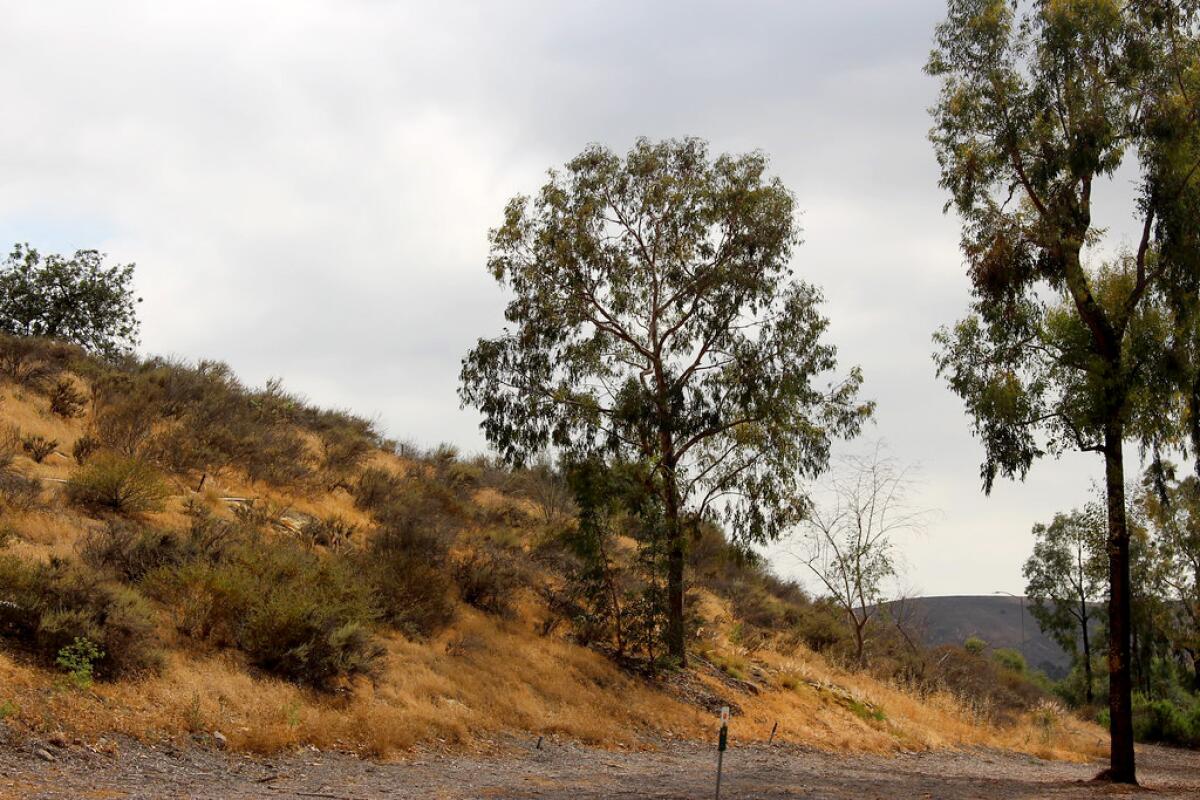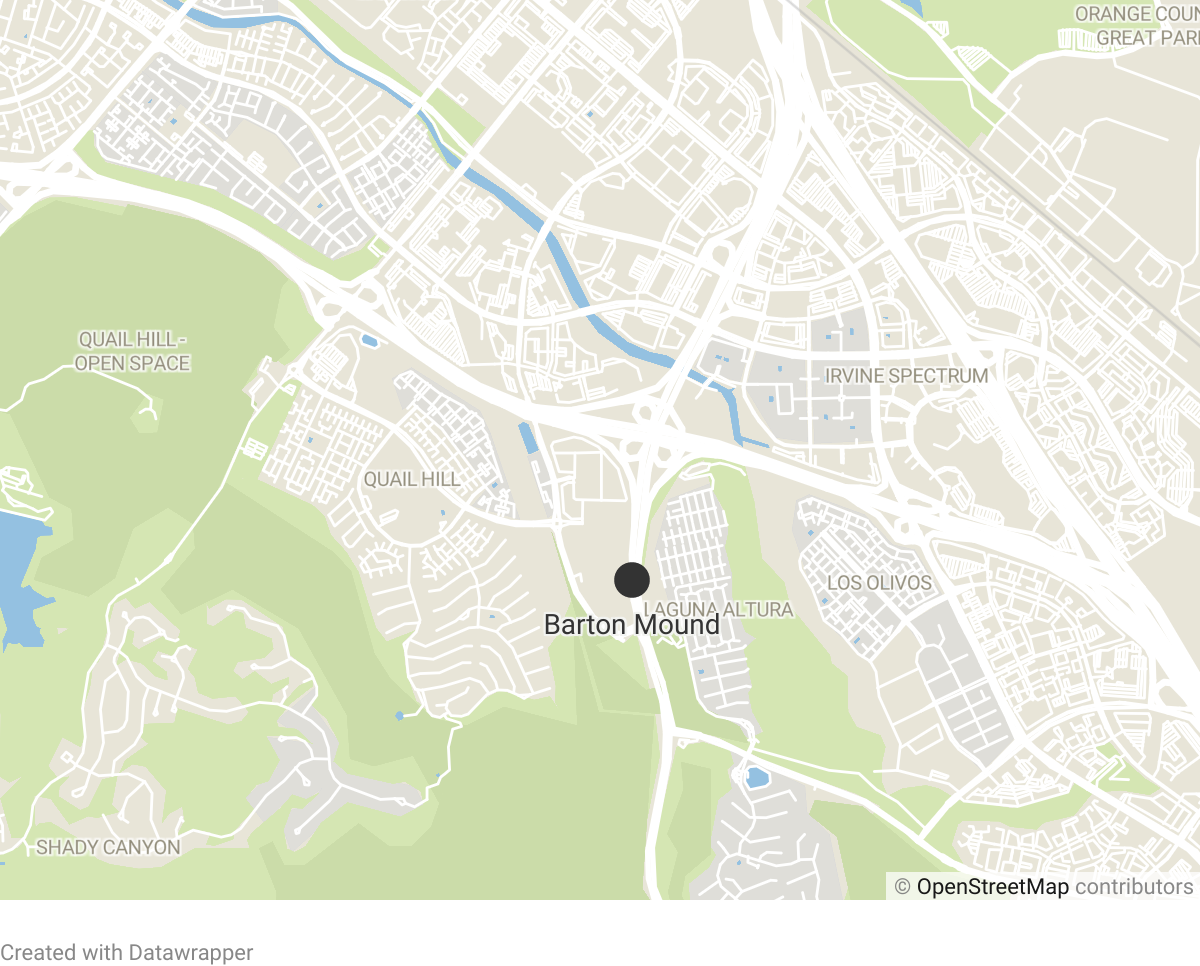Irvine to commemorate historic site where former L.A. County sheriff was killed by famed outlaw

An important piece of California history that was likely destroyed during the creation of the 405 Freeway in Irvine may finally be commemorated with a plaque after being on the state’s historic register for more than eight decades.
The Irvine City Council voted this week in favor of installing a marker at Barton Mound, the famed site where L.A. County Sheriff James Barton and three of his men were shot to death in 1857 by outlaw Juan Flores and his gang.
Flores, a convicted horse thief, had escaped from San Quentin prison and was heading south with his gang, “Las Manillas,” or the Handcuffs. Some media reports have said that about 150 outlaws and prison escapees rode with Flores, but local historian Eric Plunkett said there were only eight or nine members of the Flores gang.
They arrived in San Juan Capistrano, where they stole supplies and killed shopkeeper George Pfluggart. In response, Barton and a posse of five men rode south in pursuit of Flores and his gang. Chris Jepsen, assistant archivist of the Orange County Archives and president of the Orange County Historical Society, said that Barton was told that he didn’t have enough men to confront Flores, but he didn’t heed the warning.
After Barton and his men were killed, locals organized a posse of at least 120 to bring Flores to justice. Flores escaped capture several times, including leaping over a 200-foot drop between Modjeska and Harding canyons in Orange County. He was finally captured, and on February 14, 1857, Flores was hanged after a group of residents in Los Angeles voted for his execution.
“I’m very excited to help honor this important marker in the city, given our recent growth and place among the largest and great cities of our state,” said Councilman Mike Carroll, who proposed the item along with Councilman Anthony Kuo. “To commemorate a very important part of our state’s history and our local history here in Irvine, it’s an honor to be able to support this.”

Following direction from the City Council, city staff will now determine where the plaque should be placed along the San Diego Creek Trail, on the side of the 405 Freeway with the Los Olivos marketplace and residential community. Staff will also return to the council with various recommendations for the design of the plaque.
The city estimates that the installation of the plaque will cost about $15,000.
Jepsen said Barton Mound is one of the few historic landmarks around that doesn’t have a plaque. The site was added to California’s register of historical landmarks in 1935. The site is also identified as a historical landmark by the county and in Irvine’s general plan, according to the city.
It’s believed that the mound was destroyed when the 405 Freeway was constructed. Jepsen said it’s not unusual for historic sites in Orange County to have been razed by development.
“We have a lot of those in Orange County — there’s a lot of folks who just think old is bad in the world,” Jepsen said.
Jepsen said it’s still important to commemorate the site even if it’s been destroyed because it gets people thinking and talking about local history. He mentioned that many people seem to think that Orange County is void of significant history, and these sites help disprove that notion.
“When, for whatever reason, we haven’t saved the site itself, it’s nice that it’s still commemorated in some way,” Jepsen said. “If I had a nickel for every time somebody told me, ‘Well, there was no history here before Walt Disney came down and built Disneyland, and then all the people went to build their tract homes.’ No, no, no — 1769, that’s when we started recording the history around here.”
Jepsen said there are a number of historic sites related to the Flores jail break. Another is Flores Peak in Modjeska Canyon, where Flores famously escaped capture.
“It was a major event at the time, involving a manhunt, multiple crimes and the murder of one of the most prominent citizens in Southern California, the sheriff of Los Angeles,” Jepsen said.
Jepsen said the site is interesting to people because it lends itself to the “wild west” caricature of California that many have come to idealize.
There was a much smaller community in Orange County in the 1850s, and some joined in the posse, including a group of men called the “Rangers” from San Juan Capistrano. Jepsen said it’s unclear if the men were deputized or that was just what they were called.
“People have an interest in crime stories, they always have,” Jepsen said. “These kinds of things, I think it takes on an element of legend ... This was obviously an exception, this was not how life normally went in California at that time.”
“I don’t know that it necessarily speaks to modern Irvine’s history, in terms of the history of developing it into a suburban community ... But I think it’s good that there are reminders that this was a very different place once.”
All the latest on Orange County from Orange County.
Get our free TimesOC newsletter.
You may occasionally receive promotional content from the Daily Pilot.




